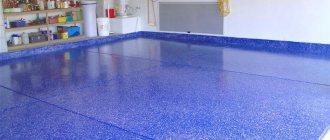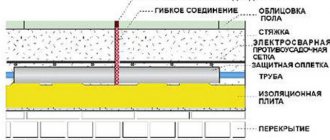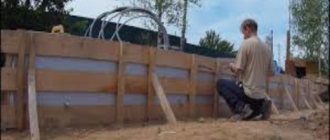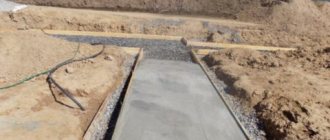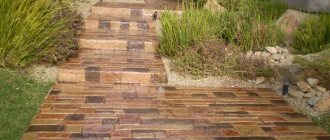Pouring the foundation is an important stage of construction at which mistakes should not be made. The strength and reliability of a building depends on a number of factors, including weather conditions. Natural phenomena such as snow, rain or heat can make changes to the established and detailed work procedure and throw even an experienced builder into a stupor. For example, rain: for a long time it was believed that such days are absolutely unsuitable for work, since they nullify all the efforts of the work team. But is this really so?
How can rainy weather affect the quality of a concrete base?
Since the foundation is a multi-layer structure, the work will be long and requires special attention, accuracy and experience from the concreting specialist. Rain is not a serious obstacle to the preparatory stage - there are no special instructions for this case in the regulations.
But during precipitation, you need to pay attention to several nuances:
- Soil composition. The soil should not be oversaturated with water. Unlike crushed stone and sand, which conduct liquid well, clay retains it, so it is better not to ignore this point.
- Method of pouring concrete. If the foundation has a complex non-standard shape, you will have to use construction vibration equipment for continuous pouring. But a large amount of precipitation can interfere in this case.
Cement is a hydraulic binder; it gains strength much faster under certain conditions: with air humidity levels of at least 80%. Therefore, some experienced builders believe that light rain or humid, cool weather will only benefit concrete: it will harden faster and this will increase the strength of the building.
You will have to use special equipment if the height of the foundation is significant. It will help displace excess moisture from the mixture and distribute the mass evenly throughout the structure. This equipment, of course, will not be cheap, but the result is worth it. If you don’t have it and you can’t purchase it, you need to compact the contents manually by tapping the wooden beams with a sledgehammer - this will create waves of vibration.
Is it possible to pour a foundation in the rain - how to prevent the structure from collapsing
The durability of the building under construction and its stability largely depend on the quality and composition of the concrete poured under the foundation. However, thoroughly described technological processes for laying concrete mixtures do not always take into account some environmental features, so weather conditions quite often make adjustments to the work schedule. There is still no clear answer to the questions of whether it is possible to pour a foundation in the rain, how justified this is and whether, in this case, the maximum quality of the frozen monolith will be achieved.
Is it worth starting work if it's raining?
You can ignore the drizzling rain, but if the weather forecasters promise heavy rain, it is better to postpone the work to another day. The optimal time of year in this case is autumn, but the risk of frost has not been canceled. Violation of the temperature regime entails stress in the unhardened concrete and freezing of the liquid. The concrete becomes loose, riddled with many microscopic pieces of ice, and cracks appear over time. Antifreeze additives will help avoid this situation.
Recommendations and features of concrete work in the rain
It is impossible to carry out concreting with bare hands, so you need to prepare the equipment in advance according to the list:
- A metal bucket, a shovel, a mixer or a concrete mixer, a wide container for stirring the composition. If the structure is large, it is a mesh.
- A piece of thick plastic film of a suitable size to cover first the finished solution, and then the poured structure.
- An electromechanical vibrator that will help remove excess moisture, avoid internal voids and make the concrete surface even stronger.
- Supply channel (for transferring the solution to a height).
Technology for preparing concrete mix in rain:
- Prepare a covered shed in advance to prevent rainwater from entering the container with the solution. It can be made from films and covered with film. Whole pieces of slate and plywood will also come to the rescue.
- Pour one part of cement into the prepared container, then 1.9 or 2 parts of river sand, and mix all the components. They must be stirred dry.
- Pour in water (half the volume of the binder). During rain, the amount can be reduced slightly.
- Add 3.9 parts of gravel (these are the proportions that will help you get concrete that has high strength and can withstand heavy loads).
- Stir the contents for 10-15 minutes.
The next stage is filling:
Place waterproofing material into the prepared frame. It will prevent moisture from penetrating from below.- Install the reinforcing mesh inside the structure (at a distance of 5-6 cm from the edge). Secure the mesh parts with wire.
- The formwork should be covered, for which the film is cut into strips. The width can be any, depending on the size of the foundation itself (plus a small margin).
- The solution is not laid all at once, but in parts, as follows: a small section of the structure is freed from the film, filled with the prepared solution, and so on until it is completely filled. After some time, the mixture will “set”; rain streams will no longer cause damage to it, so the film can be removed.
The use of plasticizers with polymers in the base makes it possible to regulate the fluidity and increase the adhesion of mixtures with metal reinforcement in the composition of the concrete itself. Such materials make the foundation even more waterproof and durable.
Excess moisture can cause mold to form under the floor. Therefore, it is necessary to equip additional ventilation ducts: they can be done while pouring concrete or after drying. Part of the foundation for organizing communications is cut out with diamond drilling using special circles.
Have you ever poured concrete in the rain?
Yes
No
Factors affecting foundation pouring in rain
To carry out work on laying concrete mortar, you should choose a period characterized by stable weather and favorable temperature conditions. It must be remembered that it takes at least a month for concrete to acquire its design strength at the optimal temperature. But what to do if the deadline for the completion of the project is running out, but there is no sign of a break in the weather, and frost is just around the corner? The best option would be to erect a temporary cover for the entire construction site where the work will be carried out. However, too large a territory will require additional attraction of significant material resources.
There are different opinions among experts regarding the possibility of pouring concrete in the rain. The question remains open and controversial, so there is simply no clear answer to it. But it should be remembered that in heavy rain and during the period of prolonged autumn rains, you should refuse to build monolithic foundations.
In any case, when concreting, you should adhere to a few simple rules that affect the final strength and durability of the future foundation monolith.
- It is required to use concrete, the binding element of which is cement of grades not lower than M-400. This cement is used in the construction of structures in contact with water. Concrete containing M-500 or M-600 grade cements has increased moisture resistance. Such solutions harden well in the rain, but their use is not entirely advisable due to the rather high cost of cement.
- It is necessary to consider the method in which the filling will be carried out. For example, when the foundation is located at great depth or has a non-standard, complex shape, significant volumes of concrete are required, which should be poured in a continuous manner. During rain, in this case, the use of special construction vibration equipment will be required. Its use will allow you to displace excess water during pouring and will prevent the formation of internal voids in the body of the monolithic mass.
- After laying the concrete mixture into the formwork during rain, it should be immediately covered with any waterproofing material, such as plastic film, to prevent excess moisture from entering and washing out the cement. After a few days, when the concrete has set, rainwater will no longer have its critical effect, so the film can be removed.
Thus, even in rainy weather, by adhering to the above recommendations and fully observing the requirements of the technological process when pouring concrete, you can achieve high-quality construction of the foundation.
What grades of concrete are best to use?
When planning to build this or that building or structure, you probably took the time and studied the characteristics of the most popular brands of cement on the market, and remembered that compositions of higher grades are also more stable. Choose brands with an index of 400 and above. Such compositions help to carry out the pouring procedure with greater comfort, without worrying about the long hardening of concrete. However, be prepared for the fact that the cost of such material will be high.
Concrete grades differ in several parameters: strength, hardening time, resistance to low temperatures and granularity (the drying speed of the finished mixture depends on this indicator).
Is it possible to pour a foundation in the rain?
A pressing question for builders who plan to erect structures in the autumn, because this is the time of year that is rich in precipitation. Let’s not hide it and immediately answer the question whether it is possible to pour concrete in the rain. Yes, you can, but a number of important factors must be observed that will affect the strength and durability of the structure. This material describes in detail how to pour in rainy weather and how to protect concrete from serious damage. Also at the end of the article you can find a description of damage caused by heavy rainfall.
Do not forget that the higher the quality of concrete, the better it resists external factors. If you want to get a reliable construction at the end, choose M500 or 600. The brands differ from each other:
- Duration of hardening.
- Strength, which also depends on the clinker.
- Resistant to low temperatures.
- Grain size - this parameter determines how quickly the concrete dries.
What happens if it rains after pouring concrete?
If, upon returning to the construction site, the bucket with cement mortar is filled with water, do not panic. The fillers are heavy, so they sink to the bottom, and the water rises to the top, that is, the liquid does not mix. You just need to pour out the excess water and mix the mixture properly.
But if the foundation pit is flooded with water, the work should definitely be stopped. It will be difficult to make a high quality base. If possible, you need to drain the pit using a drainage pump or wait until the water leaves the pit on its own.
What factors influence the pouring of the foundation in the rain?
To carry out construction work on laying a concrete composition, it is important to choose a period when the temperature and weather conditions will be most optimal. Please note that you should wait at least a month for the concrete to receive the necessary strength and reliability!
However, what to do in a situation where the deadline for the completion of the project is running out, but it’s pouring like buckets outside, and frost is not far away? An excellent option is to build a kind of tent while the foundation is being poured. There is also a minus here - organizing a canopy on an impressive territory will require additional financial costs.
Experts have different assessments of how the foundation will behave in the rain. There is no definite answer yet. But the fact remains: during periods of prolonged precipitation, you should not manually fill a monolithic foundation.
To create a strong concrete foundation, it is important to consider the following rules:
- It is necessary to use concrete solutions in construction that contain M 400 cement. It is precisely used in the construction of foundations that come into contact with water. Increased moisture resistance is inherent in cements M 500 and M 600. They harden well during precipitation, although they are not cheap.
- The next important rule is the method in which the concrete will be laid. If the foundation is supposed to be deeply buried or of an unusual shape, then it is likely that the pouring process will have to be continuous. This will require the use of special equipment that will displace the water mass and prevent the formation of voids.
- When pouring concrete mortar into pre-prepared formwork during precipitation, the concrete should be covered with waterproofing. Polyethylene is suitable as a waterproofing material. After 2-3 days, when the mixture has completely hardened, the polyethylene can be removed.
By following the above recommendations, you can avoid the critical influence of rain before and after pouring the foundation and build a solid foundation for your future wooden house.





